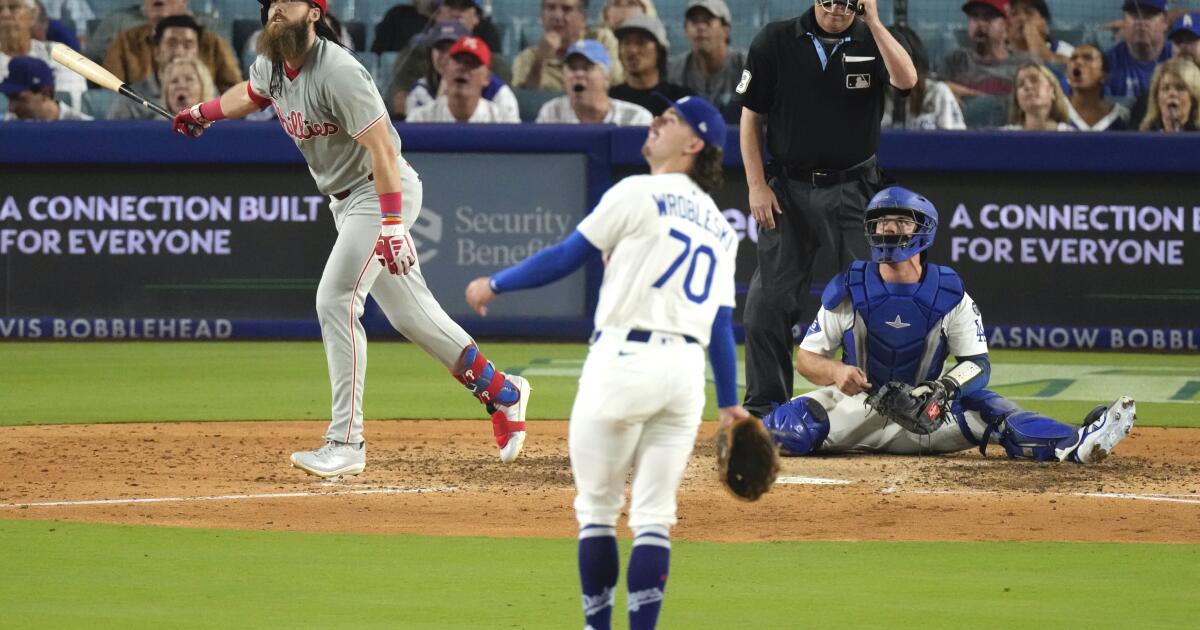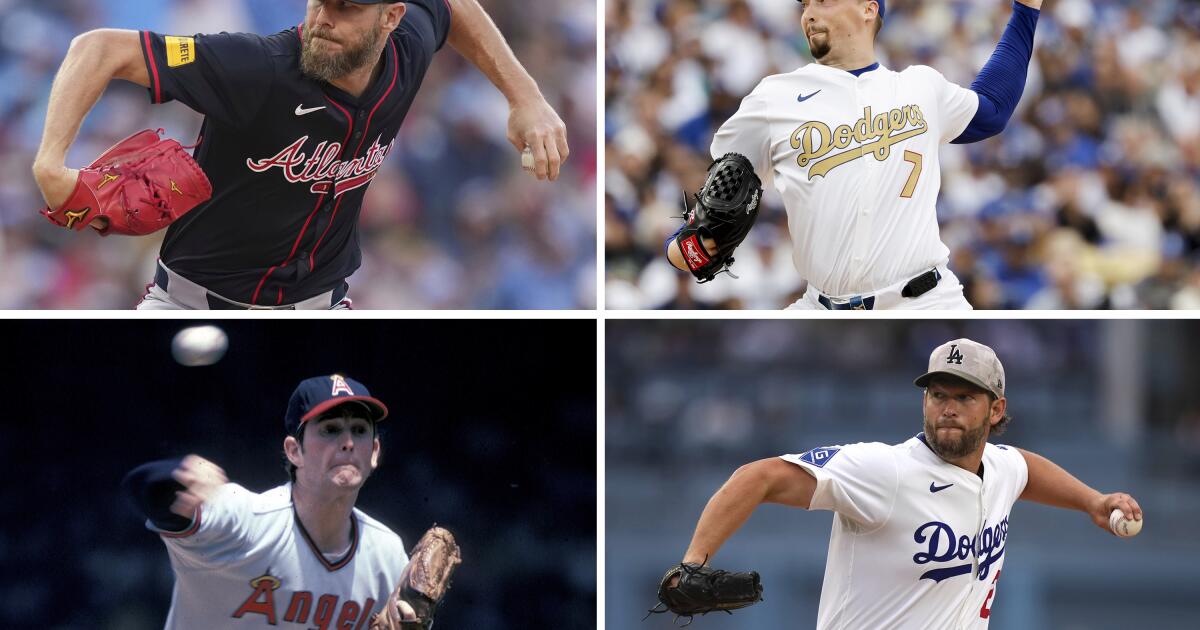Shohei Ohtani is removed after five no-hit innings, then Dodgers’ bullpen collapses in loss
It was a stressful decision. But it shouldn’t have been so consequential.
In the middle of the fifth inning Tuesday night, Shohei Ohtani returned to the Dodgers’ dugout after a clean inning of work on the mound. Waiting for him at the top step was manager Dave Roberts, who (according to the SportsNet LA television broadcast) wanted to ask how he was feeling.
With any other pitcher, there would have been no such discussion.
Over his five innings against the Philadelphia Phillies, Ohtani had not given up a hit. He had thrown only 68 pitches. And he was flashing the kind of dominance that would have made a no-hitter feel like a real possibility.
Ohtani, however, is not like any other pitcher.
He is a two-way star, coming off a second career Tommy John surgery, who has been managed with kid gloves and Bubble Wrap in his return to pitching duties this year. He started his comeback by pitching one inning, then two, then so on until he built up to five. Weeks ago, the team — in consultation with the reigning MVP — decided to avoid pushing him past the five-inning mark until at least October.
His health, both on the bump and at the plate, remains the priority.
Thus, while Ohtani reportedly told Roberts he still felt good, he laughed and said it was up to the veteran manager to decide whether or not to extend his pitching outing.
Roberts, in a continuation of the team’s careful handling of Ohtani this year, decided against it.
The result, in a continuation of the struggles from the team’s beleaguered bullpen, was disastrous.
After pulling Ohtani with a four-run lead, the Dodgers watched their relief corps melt down in predictable, reminiscent fashion. Justin Wrobleski gave up five consecutive hits with one out in the sixth, including a three-run home run to Brandon Marsh that broke open the inning. Edgardo Henriquez made matters worse, replacing Wrobleski — amid a chorus of boos directed at Roberts — later in the inning only to give up another long ball to Max Kepler.
By the time it was over, the Phillies had scored six runs to take the lead. And though the Dodgers would battle back to tie the score in the eighth, the bullpen faltered again in the ninth, when Blake Treinen gave up a decisive three-run, two-out home run to Rafael Marchán in the Phillies’ eventual 9-6 win.
For the five innings Tuesday, Ohtani displayed utter dominance against the only team to have already clinched a division title.
His fastball was playing up, eclipsing 100 mph seven times and topping out at 101.7 mph. His secondary stuff was electric, a mix of sliders and sweepers and curveballs and splitters that kept the Phillies off balance and able to make only benign contact.
After a two-out walk to Bryce Harper in the first inning, Ohtani retired the final 13 he faced. He got only six total whiffs, but was more pitch-efficient because of it, with his 68 throws coming in 19 shy of his previous season-high (he threw 87 pitches in his only other full five-inning start on Aug. 27).
That’s why, once Ohtani raced back toward the dugout to transition from pitcher to hitter in the middle of the fifth, his removal wasn’t a foregone conclusion. Why, after Roberts conversed with Ohtani from the top step, he found first baseman Freddie Freeman laughing at him back on the bench, sensing the stressfulness of his manager’s decision (which represented the ninth time in Roberts’ Dodgers tenure he had pulled a pitcher from a no-hitter in the fifth inning or later).
By that point, of course, the game shouldn’t have been in danger either way.
The Dodgers had scored three runs in the second inning on home runs from Alex Call and Kiké Hernández. They added another in the fourth off Phillies left-hander Cristopher Sánchez, handing the Cy Young contender just his fourth start this season of more than three earned runs.
But then, a bullpen that had been burned repeatedly in recent weeks (including in a 10-inning loss in the opening game of this series Monday night) played with fire again.
Wrobleski, a rookie left-hander who had been one of the Dodgers’ better relievers of late, had Rafael Marchán break up the no-no with a one-out single, Harrison Bader and Kyle Schwarber to load the bases with two more hits after that, Harper to gap a double that brought two runs across, and Marsh to go deep on a hanging 0-2 slider for a go-ahead three-run shot.
Henriquez, another rookie who had been sharp in limited action this year, yielded another home run to Kepler two batters later.
Just like that, it was 6-4 Phillies.
Ohtani helped the Dodgers get back in the game with his bat. In the eighth, he clobbered a leadoff home run deep to right field for his 50th long ball of the season, making him just the sixth player in MLB history with consecutive 50-homer campaigns.
The Dodgers kept the rally going after that, loading the bases for Call to hit a tying sacrifice fly.
Alas, the Dodgers’ bullpen did what it does best once more in the ninth, coming unglued at the worst possible moment.
After getting two quick outs to start the inning, Treinen gave up a double to Weston Wilson (the No. 7 hitter who entered with a .202 average). He fell behind 3-and-0 to Bryson Stott (the No. 8 hitter) to trigger an intentional walk. Then, in a 3-and-1 count to Marchán (the No. 9 hitter and backup catcher for the Phillies), he served up an inside cutter that Marchán pulled down the line, getting just enough behind it to send it bouncing off the top of the short right-field wall.
Nine painful runs, in four miserable innings of Dodgers relief.
Another loss, that wasted Ohtani’s no-hit (but short-lived) masterpiece.

